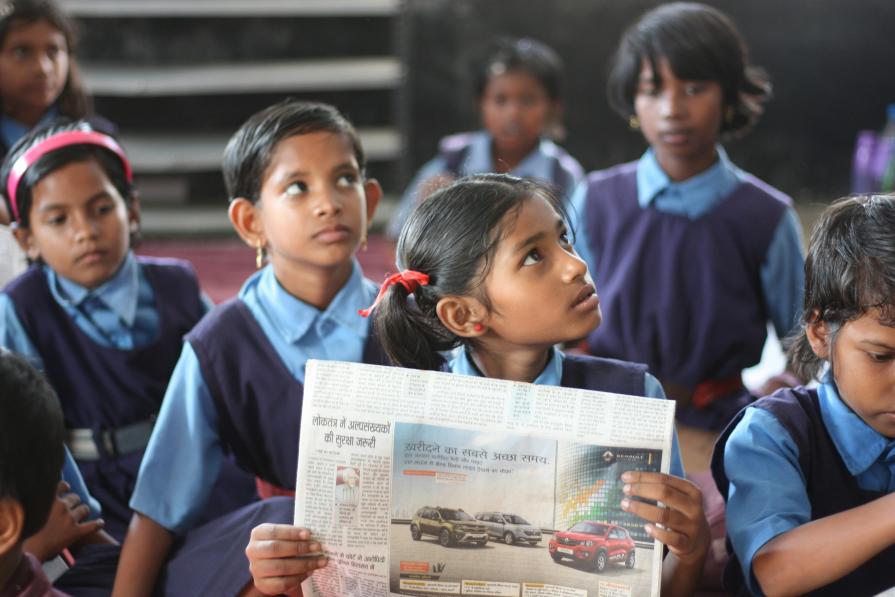In India, schooling plays a key role for many, especially among the poor, as it is not just a path to knowledge, it is a social elevator that can take children out of poverty and into a good life. But how local schools are organized and what is the chance for children to get out of poverty, experts say.
Hard Reality and Hope for Happiness
In India, poor families are forced to involve their children in hard physical labor in order not to die of hunger. Toddlers who have barely learned to walk are already helping their parents at construction sites or taking care of younger brothers and sisters, and those who are older carry loads on an equal basis with adults.
For most Indians, education is the only chance to improve their lives. The state meets these hopes by taking on the costs of education, from school uniforms to stationery. Social workers go to remote villages to tell provincial children about the advantages of education, on local TV they regularly talk about the benefits of education, through screens they show examples of people who began their journey in poverty, but with desire and perseverance, achieved incredible success. These stories inspire children and help them believe that educated citizens are the foundation of a prosperous state.

Lunch for a child in primary school costs the state only 4 rupees. The government is committed to making education accessible and cheap for every child.
Public & Private Schools
Education in public schools in India is free, but the conditions here are far from ideal. The classrooms are overcrowded with up to 80 students! In 2016, 3.5% of schools did not have toilets, and only 60% had separate toilets for boys and girls. And these are just some of the infrastructure challenges that many schools face.

Strict discipline and harsh teaching methods, including physical punishment, are becoming the norm: this does not sit well with parents, and they regularly complain to the authorities that their children are beaten in class. But if a child attends school regularly and shows good results, his family receives benefits and subsidies from the government.
In private schools, the conditions for education are much better, but the cost is high - ordinary Indians cannot afford it. In addition, fee-paying establishments hold competitions among candidates, which not everyone manages to pass. Schools for children from wealthy families offer an individual approach and learning from the best teachers.
In addition to schoolwork, many Indian children additionally go to tutors: this is especially true in a highly competitive environment, where a good certificate can be the key to success or maintaining social status. Despite the impressive statistics that more than 95% of children attend primary school, only 40% of students make the transition to secondary school.
The city of Lucknow is home to the largest school in the world. Almost 40 thousand schoolchildren study here.
Huge respect for the field
Teachers in India are highly respected in society, and their salaries range from Rs 60,000 to Rs 270,000 per year depending on their seniority. The image of a teacher, as well as a soldier, is considered one of the most respected in India.

Education in India is inextricably linked to patriotism and national identity: morning lines with the anthem and raising the flag, history lessons dedicated to national heroes, like Indira Gandhi and Jawaharlal Nehru, instill in children a deep respect for their country and its history.
It's very difficult for girls
Despite the efforts of the State, girls' education in India remains a complex issue. Existing gender stereotypes and traditions, such as the dowry system (dauri), often hinder girls' education, especially in poor and disadvantaged families.

Many parents prefer to invest resources only in the education of their sons, seeing them as the future breadwinners of the family. Even talented girls often face limitations due to traditional views on the role of women in society. However, there are also progressive Indian families who try to raise their children regardless of gender, but their numbers are smaller than those of orthodox Hindus.
The Role of Religion and Family Values in Education
In Indian society, there is a deep-rooted belief in karma and the influence of higher forces on life. Regular prayers to deities and reverence for religious traditions play a significant role in people's lives, and their behavior and relationships with relatives and in society depend on religion.
Hierarchy and respect for elders are central to Indian culture. This respect is evident in everything from greeting the older members of the family ("apku" in Hindi) to providing them with the best possible conditions in the home. This approach is the basis for the formation of moral norms in children. The tradition of worshipping and seeking counsel from elders even in adulthood is an important part of Indian culture, which reflects a deep respect for the wisdom and experience of older generations. Such traditions may seem unusual to people from other cultures, but they strengthen family ties and maintain social harmony.
Despite the fact that children in India work on an equal footing with adults from an early age, parents are very fond of babysitting them. It is not uncommon for children under the age of ten to sleep in the same bed as their parents! In some cases, boys are not allowed to do household chores or eat on their own, there is a clear division of roles and responsibilities between boys and girls, which affects their social development and education.

School education in India is a complex and multifaceted system in which hopes and ambitions, difficulties and challenges are intertwined, it serves as a tool for acquiring knowledge and a powerful social elevator that can radically change a person's life. The education system in India continues to evolve, facing challenges and finding new ways to address the challenges that stand in the way of a brighter and more educated future.





